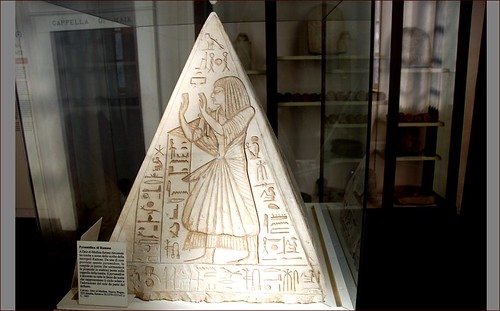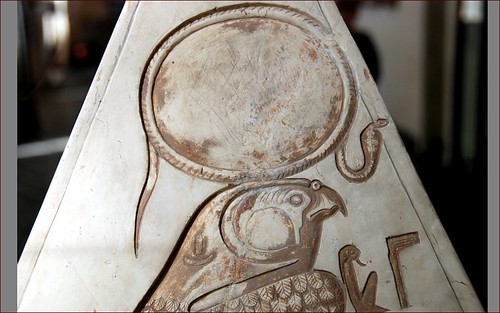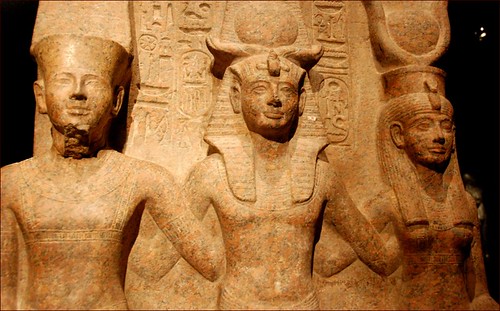Mentuhotep I
De Wikipedia, la enciclopedia libre
Tepia Mentuhotep, o Mentuhotep I, gobernante del nomo Uaset (Tebas), de c. 2119 a 2103 a. C. (von Beckerath), es considerado el primer faraón de la dinastía XI de Egipto.
En la Sala de antepasados de Karnak Mentuhothep es mencionado como sucesor de Intef y predecesor de Intef I.
En el templo de Montu en Tod existe un relieve en el que se representa a Mentuhotep con Intef II e Intef III elevando ofrendas al dios Montu.
Es el primero de los mandatarios tebanos que figura como faraón.
Guerreó contra los gobernantes de Heracleópolis de la dinastía X. Reunificó bajo su mando la región de Tebas y expandió su territorio desde Tebas hasta Dendera dominando desde el nomoAlto Egipto. IV al VI de el
Titulatura [editar]
| Titulatura | Jeroglífico | Transliteración (transcripción) - traducción - (procedencia) |
| Nombre de Horus: |
| tp.i ˁ (Tepia) El antepasado (Lista Real de Karnak nº 12) |
| Nombre de Sa-Ra: |
| mn ṯ ḥtp (Ment-hotep) Montu está satisfecho (Lista Real de Karnak nº 12) |
| it.f nṯru mnṯu ḥtp.u ˁ3 mr sṯt nbt 3bu mr h3s (Mentuhotep Itefnecheru Merysaatnebtabu...) Montu está satisfecho ...(ASAE 55, 178) |
| Predecesor: Intef, hijo de Iku | Faraón Dinastía XI | Sucesor: Intef I |
Mentuhotep I
From Wikipedia, the free encyclopedia
| Mentuhotep I | ||||
|---|---|---|---|---|
| Mentuhotpe | ||||
| Pharaoh of Egypt | ||||
| Reign | 2134 BC–?, 11th dynasty | |||
| Predecessor | - | |||
| Successor | Intef I | |||
| Children | Intef I | |||
| Died | ? | |||
Mentuhotep I was a local Egyptian prince at Thebes during the First Intermediate Period. He became the first openly acknowledged ruler of the Eleventh dynasty by assuming the title of first "supreme chief of Upper Egypt" and, later, declaring himself king over all Egypt.[2] He is named as a nomarch in Thutmose III's royal list of the 'Hall of Ancestors' monument at Karnak.[3] He was also the father of Intef I, his successor.
[edit] References
- ^ Clayton, Peter A. Chronicle of the Pharaohs: The Reign-by-Reign Record of the Rulers and Dynasties of Ancient Egypt. Thames & Hudson. p72. 2006. ISBN 0-500-28628-0
- ^ Nicholas Grimal, A History of Ancient Egypt, Blackwell Books: 1992, p.143
- ^ Grimal, p.143
| Preceded by - | Pharaoh of Egypt Eleventh Dynasty | Succeeded by Intef I |
This article about Egyptology or subjects relating to Ancient Egypt is a stub. You can help Wikipedia by expanding it. |
related articles
- Intef I
- Ankhtifi
- Intef II
- Eleventh dynasty of Egypt
- Nomarch
- Tenth dynasty of Egypt
- Herakleopolis Magna
- Timeline of ancient country changes
- Timeline of country and capital changes
- Conventional Egyptian chronology
En otros idiomas
- Català
- Deutsch
- English
- Euskara
- Suomi
- Français
- Hrvatski
- Italiano
- 한국어
- Lietuvių
- Nederlands
- Polski
- Русский
- Srpskohrvatski / Српскохрватски
- 中文
feliz año nuevo
bonne et heureuse année
Jacques
##########################################
RSS Feed de Amigos de la Egiptología
http://www.egiptologia.com/index.php?format=feed&TYPE=rss
##########################################
Foro de Discusión sobre el Antiguo Egipto
http://www.egiptologia.com/foro
Recomendamos: Proyecto Dinástico
http://www.tierradefaraones.com
--------------------------------------------------------------
LISTA DE DISTRIBUCIÓN DE AMIGOS DE LA EGIPTOLOGÍA - AE
Gestión Altas-Bajas y consulta mensajes enviados:
http://www.egiptologia.com/lista-de-distribucion.html
Moderador: Víctor Rivas egiptologia@egiptologia.com
Amigos de la Egiptología: http://www.egiptologia.com
Los mensajes de Amigos de la Egiptología son distribuidos gracias al apoyo y colaboración técnica de RedIRIS Red Académica Española - http://www.rediris.es

Cargado el 26 de junio, 2008
Galería de Hans Ollermann
King Ramses II (also called Ramses the Great) 1279-1212 B.C.
2008_0610_160520AA Egyptian Museum, Turin

Three tombs in the name of the necropolis scribe Ramose were found in Deir el-Medina.
This pyramidion formed the apex of a pyramid of bricks and surmounted the chapel of the tomb complex.
Limestone.
Deir el-Medina.
New Kingdom.
Dynasty XIX, reign of Ramses II (1279-1213 B.C.).
Egyptian Museum, Turin
2008_0610_160501AA Egyptian Museum, Turin

Three tombs in the name of the necropolis scribe Ramose were found in Deir el-Medina.
This pyramidion formed the apex of a pyramid of bricks and surmounted the chapel of the tomb complex.
Limestone.
Deir el-Medina.
New Kingdom.
Dynasty XIX, reign of Ramses II (1279-1213 B.C.).
Egyptian Museum, Turin
2008_0610_160510AA Egyptian Museum, Turin

Three tombs in the name of the necropolis scribe Ramose were found in Deir el-Medina.
This pyramidion formed the apex of a pyramid of bricks and surmounted the chapel of the tomb complex.
Limestone.
Deir el-Medina.
New Kingdom.
Dynasty XIX, reign of Ramses II (1279-1213 B.C.).
Egyptian Museum, Turin
2008_0610_160451AA Egyptian Museum, Turin

Three tombs in the name of the necropolis scribe Ramose were found in Deir el-Medina.
This pyramidion formed the apex of a pyramid of bricks and surmounted the chapel of the tomb complex.
Limestone.
Deir el-Medina.
New Kingdom.
Dynasty XIX, reign of Ramses II (1279-1213 B.C.).
Egyptian Museum, Turin
2008_0610_143204AA Egyptian Museum, Turin

Ramses II is seated with Amun and his consort Mut, both considered as protectors of the Royal Family of the Lands of Egypt. His Majesty wears the Atef crown that is composed of the sundisk and ram horns with feathers of Justice.
Egyptian Museum, Turin.


![Q3 [p] p](http://es.wikipedia.org/w/extensions/wikihiero/img/hiero_Q3.png)





![N35 [n] n](http://es.wikipedia.org/w/extensions/wikihiero/img/hiero_N35.png)


![X1 [t] t](http://es.wikipedia.org/w/extensions/wikihiero/img/hiero_X1.png)


![I9 [f] f](http://es.wikipedia.org/w/extensions/wikihiero/img/hiero_I9.png)

![G43 [w] w](http://es.wikipedia.org/w/extensions/wikihiero/img/hiero_G43.png)

![S29 [s] s](http://es.wikipedia.org/w/extensions/wikihiero/img/hiero_S29.png)
![F29 [sti] sti](http://es.wikipedia.org/w/extensions/wikihiero/img/hiero_F29.png)
![V30 [nb] nb](http://es.wikipedia.org/w/extensions/wikihiero/img/hiero_V30.png)

![D58 [b] b](http://es.wikipedia.org/w/extensions/wikihiero/img/hiero_D58.png)


![U6 [mr] mr](http://es.wikipedia.org/w/extensions/wikihiero/img/hiero_U6.png)
 " alt=">" height="44px">
" alt=">" height="44px">

![Y5 [mn] mn](http://en.wikipedia.org/w/extensions/wikihiero/img/hiero_Y5.png)
![N35 [n] n](http://en.wikipedia.org/w/extensions/wikihiero/img/hiero_N35.png)
![V13 [T] T](http://en.wikipedia.org/w/extensions/wikihiero/img/hiero_V13.png)
![G43 [w] w](http://en.wikipedia.org/w/extensions/wikihiero/img/hiero_G43.png)
![R4 [Htp] Htp](http://en.wikipedia.org/w/extensions/wikihiero/img/hiero_R4.png)
![X1 [t] t](http://en.wikipedia.org/w/extensions/wikihiero/img/hiero_X1.png)
![Q3 [p] p](http://en.wikipedia.org/w/extensions/wikihiero/img/hiero_Q3.png)


No hay comentarios:
Publicar un comentario